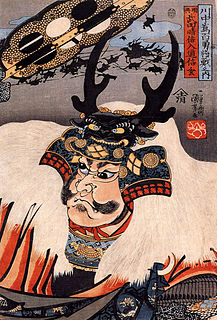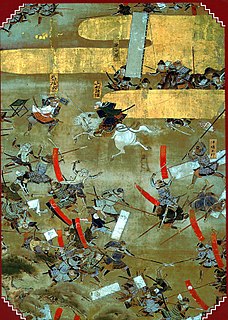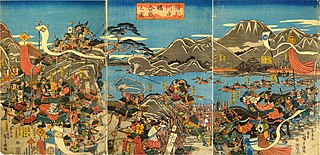
The battles of Kawanakajima were fought in the Sengoku period of Japan between Takeda Shingen of Kai Province and Uesugi Kenshin of Echigo Province in the plain of Kawanakajima, Nagano, "the island between the rivers", in the north of Shinano Province. The location is in the southern part of the present-day city of Nagano. Five major battles took place there: Fuse in 1553, Saigawa in 1555, Uenohara in 1557, Hachimanbara in 1561, and Shiozaki in 1564. The best known and most severe among them was fought on October 18, 1561, and was only fought in the heart of the Kawanakajima plain, thus being the "battle of Kawanakajima". The battles were fought after Shingen conquered Shinano, expelling Ogasawara Nagatoki and Murakami Yoshikiyo, who subsequently turned to Kenshin for help. The battles became one of the most cherished tales in Japanese military history, the epitome of Japanese chivalry and romance, mentioned in epic literature, woodblock printing and movies.

Akiyama Nobutomo was a samurai during the Age of Warring States in Japan. He is known as one of the "Twenty-Four Generals of Takeda Shingen". Nobutomo also served under Shingen's son, Takeda Katsuyori.
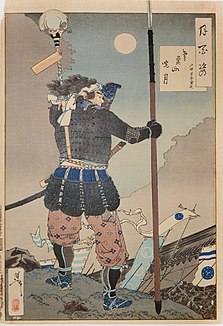
The Battle of Nagashino took place in 1575 near Nagashino Castle on the plain of Shitarabara in the Mikawa Province of Japan. Takeda Katsuyori attacked the castle when Okudaira Sadamasa rejoined the Tokugawa, and when his original plot with Oga Yashiro for taking Okazaki Castle, the capital of Mikawa, was discovered.
The Siege of Noda Castle (野田城の戦い) took place from January to February 1573, between the forces of the Takeda clan, led by the noted warlord Takeda Shingen, against the Tokugawa clan, led by Tokugawa Ieyasu. Along with the Battle of Mikatagahara it was one of the final battles in Takeda Shingen's long career.

Kōsa, also known as Hongan-ji Kennyo, was the 11th head of the Hongan-ji in Kyoto, and Chief Abbot of Ishiyama Hongan-ji, cathedral fortress of the Ikkō-ikki, during its siege at the end of the Sengoku period. He engineered many alliances, and organized the defenses of the cathedral to the point that most at the time considered Ishiyama Hongan-ji to be unbreachable.
Odawara Castle in today's Odawara city, Kanagawa Prefecture, Japan, was besieged three times.
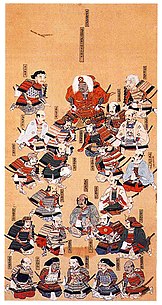
The Twenty-Four Generals were just one of many historically famous groupings of battle commanders from Japan's Sengoku Period. These Twenty-Four were the most trusted companions of Takeda Shingen. A third of them died at the famous Battle of Nagashino in 1575 when they led the Takeda forces against Oda Nobunaga. When Takeda Katsuyori committed suicide in 1582, declaring the end of the Takeda clan, only three of them were still serving under the Takeda.
Suwa Yorishige (諏訪頼重) (1516–1544) was a Japanese samurai and head of the Suwa clan. He was defeated by Takeda Shingen, and his daughter Suwa Goryōnin was taken as Shingen's concubine. She later gave birth to the Takeda clan heir Takeda Katsuyori.

Sanada Yukitaka was a Japanese samurai warrior of the Sengoku period. He is known as one of the "Twenty-Four Generals of Takeda Shingen".
The 1549 siege of Fukashi was executed by Takeda Shingen during his campaign to take Shinano province. Fukashi was one of several minor fortresses controlled by Ogasawara Nagatoki and lost to Shingen.
The first siege of Hachigata took place in 1568; Takeda Shingen laid siege to the castle, which was controlled by Hōjō Ujikuni, but was unable to capture it. Shingen then moved south to besiege Takiyama castle, on his way to the Hōjō capital of Odawara.
The sieges of Toishi castle took place during Takeda Shingen's campaign to take over Shinano Province. His army, led by Sanada Yukitaka, began sieging the castle in 1550. The defending lord, Murakami Yoshikiyo, held out until the following year, but his garrison suffered over 1000 casualties, and was ultimately forced to surrender.
The 1570 siege of Hanazawa was one of several battles fought between the Takeda and Imagawa clans during the Takeda's campaign to seize Suruga province, during Japan's Sengoku period.
The 1554 siege of Kiso-Fukushima was a siege by Takeda Shingen on Fukushima Castle, in the Kiso River Valley of Shinano province. This was one of many battles fought during Shingen's campaign to seize control of Shinano.
The 1554 siege of Kannomine was one of many battles fought in Takeda Shingen's campaign to seize control of Shinano Province. This took place during Japan's Sengoku period; Shingen was one of many feudal lords (daimyōs) who battled to gain land and power.
The 1554 siege of Matsuo was one of many sieges undertaken by the daimyō Takeda Shingen in his campaign to conquer Japan's Shinano Province. This took place during Japan's Sengoku period, in which feudal lords (daimyōs) vied for control of fiefdoms across the country.
The 1569 siege of Kanbara was one of many sieges undertaken by the Takeda clan against the territories of the Hōjō clan during Japan's Sengoku period. Takeda Katsuyori, the son of clan head Takeda Shingen, led the siege against Kanbara castle in Suruga province, which was held by a garrison of 1000 men under the command of Hōjō Sōun's nephew Hōjō Tsunashige.
The 1571 siege of Fukazawa was one of a number of battles which formed Takeda Shingen's campaigns against the Hōjō clan, during Japan's Sengoku period. Having burned the town of Odawara surrounding the Hōjō home castle two years earlier, he laid siege to a number of other Hōjō holdings in the surrounding provinces, including Fukazawa, in Suruga province.

Minowa Castle is a castle located in Takasaki, Gunma Prefecture, Japan.
